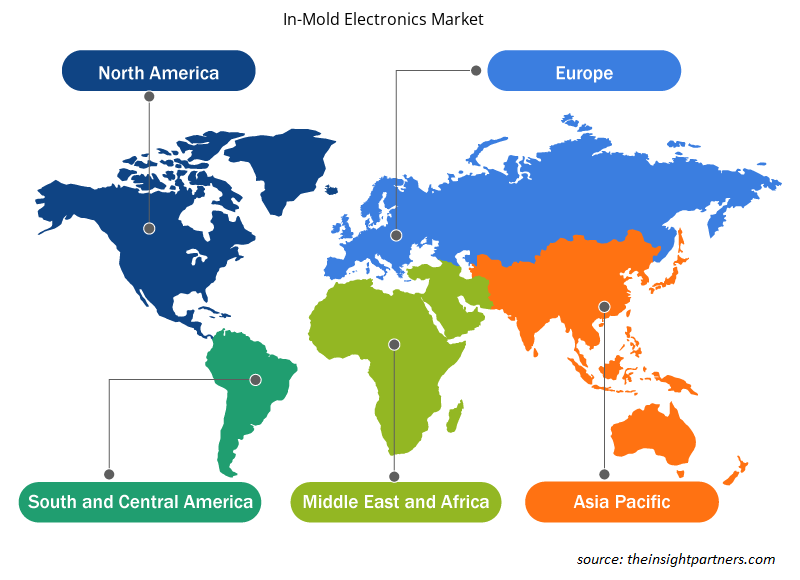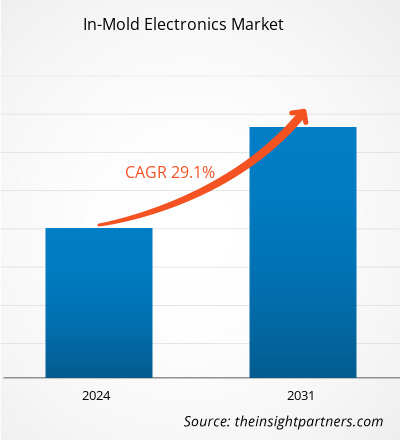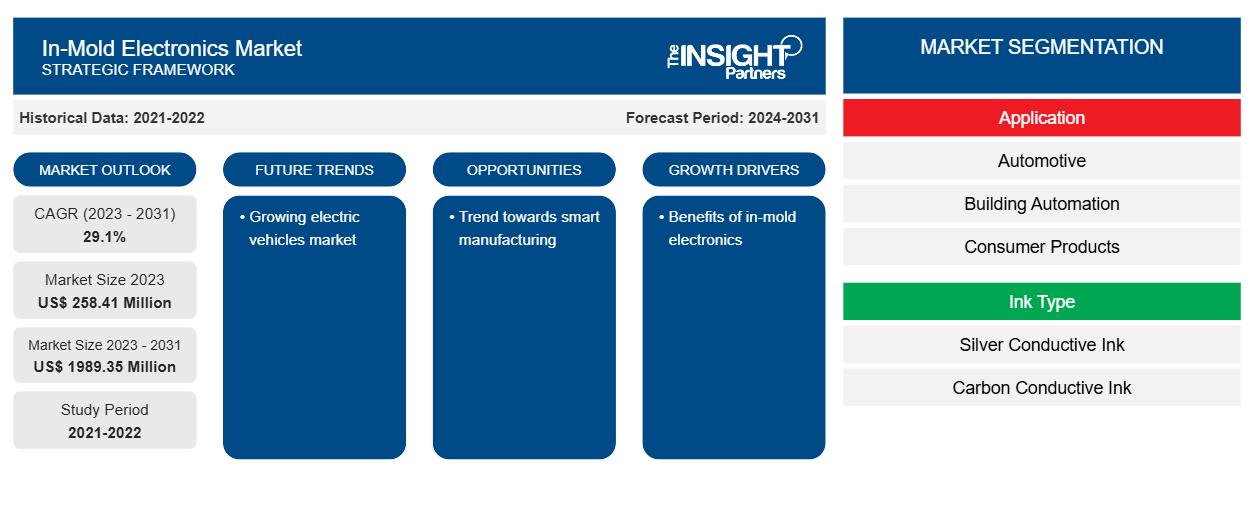Si prevede che la dimensione del mercato dell'elettronica in-mold raggiungerà i 1989,35 milioni di dollari entro il 2031, rispetto ai 258,41 milioni di dollari del 2023. Si prevede che il mercato registrerà un CAGR del 29,1% nel 2023-2031. Il crescente mercato dell'elettronica di consumo e la crescente domanda del settore automobilistico rimarranno probabilmente fondamentali per le tendenze del mercato dell'elettronica in-mold.
Analisi del mercato dell'elettronica in stampo
Diversi fattori chiave contribuiscono alla crescente popolarità dell'elettronica in-mold. L'elettronica in-mold consente la creazione di interfacce eleganti e discrete che si fondono facilmente nel design complessivo del prodotto. Questa integrazione migliora l'esperienza utente e aumenta la domanda tra i consumatori. Un altro fattore è che l'eliminazione di componenti aggiuntivi, come schede di circuito e connettori, semplifica l'assemblaggio e riduce i costi di produzione complessivi. Il processo di produzione semplificato consente un time-to-market più rapido, rendendo l'elettronica in-mold un'opzione interessante per le aziende che cercano di rispettare scadenze ravvicinate e ottenere un vantaggio competitivo.
Panoramica del mercato dell'elettronica in-mold
L'elettronica in-mold è un processo di produzione che combina circuiti elettronici con un componente in plastica stampata. Combinando le tradizionali tecniche di stampaggio a iniezione con l'elettronica stampata, l'elettronica in-mold elimina la necessità di circuiti stampati, connettori e cavi separati. Tracce conduttive, sensori tattili e altri componenti elettronici sono integrati direttamente nella superficie della plastica, offrendo numerosi vantaggi rispetto ai metodi tradizionali. È ampiamente utilizzato per elettrodomestici, cruscotti per automobili, apparecchiature mediche, aerospaziali ed elettronica indossabile.
Personalizza questo report in base alle tue esigenze
Riceverai la personalizzazione gratuita di qualsiasi report, comprese parti di questo report, o analisi a livello nazionale, pacchetto dati Excel, oltre a usufruire di grandi offerte e sconti per start-up e università
-
Scopri le principali tendenze di mercato in questo rapporto.Questo campione GRATUITO includerà analisi di dati che spaziano dalle tendenze di mercato alle stime e alle previsioni.
Driver e opportunità del mercato dell'elettronica in-mold
Vantaggi dell'elettronica in-mold per favorire il mercato
L'elettronica in-mold può incorporare grafica decorativa, illuminazione e molti altri elementi, il che ne determina la domanda tra i consumatori. Offre una maggiore flessibilità di progettazione, affidabilità e durata migliorate, una significativa riduzione di spazio e peso, prestazioni touch migliorate, facilità di assemblaggio e sostenibilità. L'elettronica in-mold ha guadagnato popolarità in diversi settori per interfacce uomo-macchina come unità di controllo passeggeri, telecomandi, interfacce di sistemi di gestione della cabina, sistemi di monitoraggio dei pazienti, elettrodomestici, sistemi di sicurezza domestica e altri. Inoltre, è anche una scelta popolare per interni di automobili e cabine di aeromobili per design eleganti e compatti.
Crescita del mercato dei veicoli elettrici
Si prevede che la domanda di veicoli elettrici aumenterà in futuro a causa di un aumento delle preoccupazioni sui cambiamenti climatici e sull'inquinamento atmosferico. I governi di diversi paesi stanno cercando di introdurre diverse iniziative e politiche per alimentare la produzione di veicoli elettrici per contribuire a un futuro più verde. Quindi, la produzione di veicoli elettrici genererà la domanda di elettronica in-mold per aumentare il contenuto elettronico, ridurre la complessità e ridurre il peso nei veicoli. Si prevede che alcuni dei casi menzionati di seguito alimenteranno la produzione di veicoli elettrici nel prossimo futuro.
- A settembre 2022, il governo degli Stati Uniti ha annunciato il suo piano per incrementare la produzione di veicoli elettrici. Entro il 2030, si prevede che il paese registrerà il 50% della quota totale di vendite di veicoli elettrici. Aziende come Honda, Toyota, General Motors, Ford Motor Company e Panasonic hanno annunciato investimenti nei settori manifatturieri in North Carolina, Missouri, Michigan, Kansas e Ohio per raggiungere l'obiettivo.
- A maggio 2022, Stellantis aveva pianificato di spendere 2,8 miliardi di dollari per aumentare la produzione di veicoli elettrici in due dei suoi stabilimenti canadesi. A sostegno di questo investimento, i governi canadese e dell'Ontario hanno pianificato di investire fino a 410,7 milioni di dollari e 398 milioni di dollari per aumentare la produzione nazionale di veicoli elettrici e mitigare i vincoli della catena di fornitura.
- Il governo degli Emirati Arabi Uniti ha pianificato di lanciare 42.000 auto elettriche, che saranno sulle strade entro il 2030. Le politiche e gli incentivi governativi di supporto offrono opportunità vantaggiose ai principali attori per promuovere l'adozione di veicoli elettrici nel paese.
Analisi della segmentazione del rapporto di mercato dell'elettronica in stampo
I segmenti chiave che hanno contribuito alla derivazione dell'analisi di mercato dell'elettronica in stampo sono il tipo di inchiostro e l'applicazione.
- Per applicazione, il mercato è segmentato in automotive, building automation, consumer products, wearable, healthcare e altri. Si prevede che il segmento automotive crescerà con il CAGR più elevato.
- In base al tipo di inchiostro, il mercato è segmentato in inchiostro conduttivo all'argento, inchiostro conduttivo al carbonio e altri. Il segmento dell'inchiostro conduttivo all'argento ha detenuto una quota di mercato maggiore nel 2023.
Analisi della quota di mercato dell'elettronica in stampo per area geografica
L'ambito geografico del rapporto sul mercato dell'elettronica in stampo è suddiviso principalmente in cinque regioni: Nord America, Asia Pacifico, Europa, Medio Oriente e Africa e Sud America/Sud e Centro America.
In termini di fatturato, l'Asia Pacifica ha rappresentato la quota di mercato più grande dell'elettronica in-mold nel 2023. La presenza di un gran numero di produttori di elettronica nella regione porta alla crescita del mercato della regione. L'impennata della crescita demografica alimenta la domanda di elettronica di consumo nella regione, guidando l'uso della tecnologia elettronica in-mold. L'aumento del reddito disponibile delle persone nelle economie emergenti come India e Cina porta al loro forte potere d'acquisto per l'elettronica, che porta ulteriormente alla crescente domanda di tecnologia elettronica in-mold.
Approfondimenti regionali sul mercato dell'elettronica in-mold
Le tendenze regionali e i fattori che influenzano il mercato dell'elettronica in-mold durante il periodo di previsione sono stati ampiamente spiegati dagli analisti di Insight Partners. Questa sezione discute anche i segmenti e la geografia del mercato dell'elettronica in-mold in Nord America, Europa, Asia Pacifico, Medio Oriente e Africa e America meridionale e centrale.

- Ottieni i dati specifici regionali per il mercato dell'elettronica in-mold
Ambito del rapporto sul mercato dell'elettronica in stampo
| Attributo del report | Dettagli |
|---|---|
| Dimensioni del mercato nel 2023 | 258,41 milioni di dollari USA |
| Dimensioni del mercato entro il 2031 | 1989,35 milioni di dollari USA |
| CAGR globale (2023-2031) | 29,1% |
| Dati storici | 2021-2022 |
| Periodo di previsione | 2024-2031 |
| Segmenti coperti |
Per applicazione
|
| Regioni e Paesi coperti |
America del Nord
|
| Leader di mercato e profili aziendali chiave |
|
Densità degli attori del mercato dell'elettronica in-mold: comprendere il suo impatto sulle dinamiche aziendali
Il mercato dell'elettronica in-mold sta crescendo rapidamente, spinto dalla crescente domanda degli utenti finali dovuta a fattori quali l'evoluzione delle preferenze dei consumatori, i progressi tecnologici e una maggiore consapevolezza dei vantaggi del prodotto. Con l'aumento della domanda, le aziende stanno ampliando le loro offerte, innovando per soddisfare le esigenze dei consumatori e capitalizzando sulle tendenze emergenti, il che alimenta ulteriormente la crescita del mercato.
La densità degli operatori di mercato si riferisce alla distribuzione di aziende o società che operano in un particolare mercato o settore. Indica quanti concorrenti (operatori di mercato) sono presenti in un dato spazio di mercato in relazione alle sue dimensioni o al valore di mercato totale.
Le principali aziende che operano nel mercato dell'elettronica in-mold sono:
- Società Celanese
- e 2 ip
- Industrie DuraTech
- Produzione est-ovest
- GenesInk
- Prodotti Golden Valley
Disclaimer : le aziende elencate sopra non sono classificate secondo un ordine particolare.

- Ottieni una panoramica dei principali attori del mercato dell'elettronica in-mold
Notizie e sviluppi recenti sul mercato dell'elettronica in-mold
Il mercato dell'elettronica in-mold viene valutato raccogliendo dati qualitativi e quantitativi dopo la ricerca primaria e secondaria, che include importanti pubblicazioni aziendali, dati associativi e database. Di seguito è riportato un elenco degli sviluppi nel mercato:
- A settembre 2022, X2F ha annunciato di aver aderito a una collaborazione unica con Covestro, uno dei principali produttori mondiali di materiali polimerici di alta qualità, per sviluppare un dissipatore di calore per autoveicoli termicamente conduttivo con elettronica in-mold utilizzando la tecnologia di stampaggio a viscosità controllata trasformativa di X2F. Questo nuovo prodotto è stata un'alternativa unica per gli OEM e i trasformatori del settore automobilistico che cercano un sostituto per i dissipatori di calore in alluminio pressofuso che sia più leggero e più conveniente. (Fonte: X2F, comunicato stampa, 2022)
Copertura e risultati del rapporto sul mercato dell'elettronica in stampo
Il rapporto "Dimensioni e previsioni del mercato dell'elettronica in stampo (2021-2031)" fornisce un'analisi dettagliata del mercato che copre le seguenti aree:
- Dimensioni del mercato e previsioni a livello globale, regionale e nazionale per tutti i segmenti di mercato chiave coperti dall'ambito
- Dinamiche di mercato come fattori trainanti, vincoli e opportunità chiave
- Principali tendenze future
- Analisi dettagliata delle cinque forze PEST/Porter e SWOT
- Analisi di mercato globale e regionale che copre le principali tendenze di mercato, i principali attori, le normative e gli sviluppi recenti del mercato
- Analisi del panorama industriale e della concorrenza che copre la concentrazione del mercato, l'analisi della mappa di calore, i principali attori e gli sviluppi recenti
- Profili aziendali dettagliati
- Analisi storica (2 anni), anno base, previsione (7 anni) con CAGR
- Analisi PEST e SWOT
- Valore/volume delle dimensioni del mercato - Globale, Regionale, Nazionale
- Industria e panorama competitivo
- Set di dati Excel
Report recenti
Testimonianze
Motivo dell'acquisto
- Processo decisionale informato
- Comprensione delle dinamiche di mercato
- Analisi competitiva
- Analisi dei clienti
- Previsioni di mercato
- Mitigazione del rischio
- Pianificazione strategica
- Giustificazione degli investimenti
- Identificazione dei mercati emergenti
- Miglioramento delle strategie di marketing
- Aumento dell'efficienza operativa
- Allineamento alle tendenze normative























 Ottieni un campione gratuito per - Mercato dell'elettronica in-mold
Ottieni un campione gratuito per - Mercato dell'elettronica in-mold